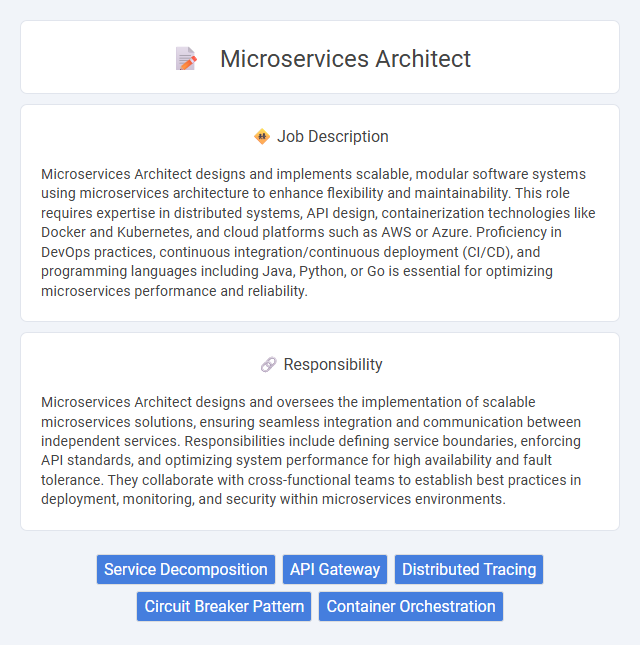
Microservices Architect designs and implements scalable, modular software systems using microservices architecture to enhance flexibility and maintainability. This role requires expertise in distributed systems, API design, containerization technologies like Docker and Kubernetes, and cloud platforms such as AWS or Azure. Proficiency in DevOps practices, continuous integration/continuous deployment (CI/CD), and programming languages including Java, Python, or Go is essential for optimizing microservices performance and reliability.
Individuals with strong problem-solving skills and adaptability are likely to thrive as Microservices Architects, given the complex and evolving nature of distributed systems. Candidates who enjoy collaboration, continuous learning, and handling system scalability challenges may find this role well-suited to their strengths. Conversely, those who prefer routine tasks or struggle with ambiguity might face difficulties succeeding in this position.
Qualification
Microservices Architect roles demand expertise in designing scalable, resilient distributed systems using containerization technologies like Docker and orchestration platforms such as Kubernetes. Proficiency in programming languages including Java, Python, or Go, coupled with a deep understanding of API design, RESTful services, and event-driven architectures, is essential. Strong skills in cloud platforms (AWS, Azure, or GCP), CI/CD pipelines, and knowledge of domain-driven design principles further qualify candidates for this position.
Responsibility
Microservices Architect designs and oversees the implementation of scalable microservices solutions, ensuring seamless integration and communication between independent services. Responsibilities include defining service boundaries, enforcing API standards, and optimizing system performance for high availability and fault tolerance. They collaborate with cross-functional teams to establish best practices in deployment, monitoring, and security within microservices environments.
Benefit
Microservices Architect roles likely offer significant benefits such as enhanced scalability and flexibility in software development, enabling organizations to adapt quickly to changing market demands. They often provide opportunities to work with cutting-edge technologies and foster innovation through modular service design. This position probably improves system resilience and allows continuous deployment, leading to faster delivery of features and updates.
Challenge
Microservices Architect roles likely present challenges related to designing scalable and resilient distributed systems while managing complex inter-service communication. Balancing service autonomy with data consistency may pose significant difficulty, requiring deep expertise in both domain-driven design and cloud infrastructure. Navigating organizational change and ensuring seamless integration across diverse teams might also be expected as part of the role's demanding environment.
Career Advancement
Microservices Architect roles offer significant career advancement opportunities by enabling professionals to lead the design and implementation of scalable, modular software systems in cloud environments. Mastery in containerization, orchestration tools like Kubernetes, and API management positions candidates for senior leadership roles such as Chief Technology Officer or Enterprise Architect. Developing expertise in microservices architecture drives innovation and opens pathways to strategic decision-making and high-impact project management within tech enterprises.
Key Terms
Service Decomposition
Microservices Architects specialize in service decomposition by breaking down complex monolithic applications into smaller, manageable, and independently deployable services. This process involves identifying bounded contexts, designing clear service boundaries, and ensuring each microservice encapsulates specific business capabilities for scalability and resilience. Effective service decomposition enhances system maintainability, accelerates delivery, and improves fault isolation within distributed architectures.
API Gateway
Microservices Architects design and implement scalable API Gateway solutions that route, secure, and manage communication between microservices, ensuring efficient data flow and robust authentication. They optimize API Gateway performance to handle high request volumes while maintaining low latency and seamless integration with service meshes and container orchestration platforms like Kubernetes. Expertise in API Gateway tools such as Kong, AWS API Gateway, or Apigee is critical for securing microservices with policies on rate limiting, analytics, and fault tolerance.
Distributed Tracing
Microservices Architect roles demand expertise in implementing distributed tracing to monitor and debug complex service interactions across cloud-native environments. Proficiency with tools like Jaeger, Zipkin, and OpenTelemetry enhances visibility into microservice performance, enabling efficient identification of bottlenecks and latency issues. Deep understanding of distributed tracing protocols, context propagation, and correlation IDs is critical to ensuring reliable observability in large-scale microservices architectures.
Circuit Breaker Pattern
Microservices Architects design and implement scalable, resilient systems by leveraging the Circuit Breaker Pattern to prevent cascading failures and ensure system stability under high load or partial outages. This pattern monitors service interactions and trips the circuit to stop requests when a downstream service is unresponsive, facilitating fallback mechanisms and improving overall system fault tolerance. Expertise in tools like Netflix Hystrix, Resilience4j, and Spring Cloud Circuit Breaker is essential for optimizing microservice communication and maintaining uptime in distributed architectures.
Container Orchestration
Microservices Architect designs scalable systems by decomposing applications into independently deployable microservices, optimizing agility and performance. Expertise in container orchestration platforms like Kubernetes and Docker Swarm ensures efficient deployment, scaling, and management of containerized applications across clusters. Proficient in automating service discovery, load balancing, and rolling updates, enabling resilient and fault-tolerant microservices ecosystems.
 kuljobs.com
kuljobs.com